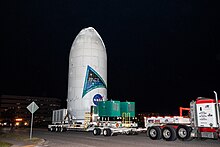User:Sdsds/sandbox/Payload encapsulation and integration

In robotic spacecraft missions, payload encapsulation and integration are among the final preparation steps prior to launch. Encapsulation of the payload is performed in a payload processing facility under cleanroom conditions.[1] The payload and encapsulating fairing segments are usually upright during the process. Attachment and integration with the launch vehicle is performed either vertically by stacking the encapsulated payload above the upright launch vehicle, or horizontally before the integrated vehicle is brought upright on the launch stand.
Encapsulation
[edit]Access to spacecraft becomes more difficult after encapsulation. According to a United States Space Force official, "Encapsulation signifies the end of production for the satellite and the start of the final stages of launch preparations.”[2] Often a single fairing is used to encapsulate multiple payloads that will be launched together.[2][a] As early as 1983, Arianespace recognized the need to support dual payload launches on the Ariane 4 launch vehicle.[3]
Horizontal encapsulation
[edit]The Pegasus launch system used horizontal payload encapsulation.[4] Pegasus vehicles are air launched and are released horizontally from beneath a carrier aircraft.
Vertical encapsulation
[edit]
Most commonly the payload is placed atop a payload adapter before encapsulation. The combined assembly is then transported vertically to the launch site, or rotated horizontally for transport.
Integration
[edit]The encapsulated payloads are connected mechanically and usually electrically to the upper stage of the launch vehicle. The electrical connections allow payload batteries to remain charged and allow mission controllers to monitor payload health while the vehicle is on the launch pad. A payload adapter and payload separation system form the mechanical connection.
Horizontal integration
[edit]The Pegasus and Falcon 9 launch systems are examples where the payload is integrated with the launch vehicle while they are in a horizontal orientation.
Vertical integration
[edit]Some customers have spacecraft requiring vertical integration.[5]
References
[edit]- ^ "Satellite and Payload Processing". L3Harris.
- ^ a b ""Encapsulation 101"—What is it and why does it matter?". Satnews.
- ^ "SPELDA (Dual payload launch structure for Ariane)". Engineering with composites; Proceedings of the Third Technology Conference. 1983.
- ^ "NASAfacts - Inside the MPPF" (PDF). NASA.
- ^ Lentz, Danny; et al. (22 July 2023). "Space Force releases NSSL phase three second draft". NASASpaceflight.com.
Sources
[edit]See also
[edit]- https://wiki.riteme.site/w/index.php?search=Payload+encapsulation+and+integration&title=Special%3ASearch&ns0=1
- https://wiki.riteme.site/w/index.php?search=spacecraft+processing+facility&title=Special%3ASearch&ns0=1
Cite error: There are <ref group=lower-alpha> tags or {{efn}} templates on this page, but the references will not show without a {{reflist|group=lower-alpha}} template or {{notelist}} template (see the help page).
